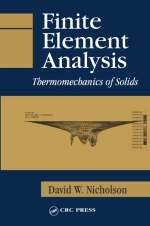
Finite Element Analysis
Crc Press Inc (Verlag)
978-0-8493-0749-2 (ISBN)
- Titel erscheint in neuer Auflage
- Artikel merken
Finite element modeling has developed into one of the most important tools at an engineer's disposal, especially in applications involving nonlinearity. While engineers coping with such applications may have access to powerful computers and finite element codes, too often they lack the strong foundation in finite element analysis (FEA) that nonlinear problems require.
Finite Element Analysis: Thermomechanics of Solids builds that foundation. It offers a comprehensive, unified presentation of FEA applied to coupled mechanical and thermal, static and dynamic, and linear and nonlinear responses of solids and structures. The treatment first establishes the mathematical background, then moves from the basics of continuum thermomechanics through the finite element method for linear media to nonlinear problems based on a unified set of incremental variational principles.
As the use of FEA in advanced materials and applications continues to grow and with the integration of FEA with CAD, rapid prototyping, and visualization technology, it becomes increasingly important that engineers fully understand the principles and techniques of FEA. This book offers the opportunity to gain that understanding through a treatment that is concise yet comprehensive, detailed, and practical.
MATHEMATICAL FOUNDATIONS: VECTORS AND MATRICES
Introduction
Vectors
Matrices
MATHEMATICAL FOUNDATIONS: TENSORS
Tensors
Divergence, Curl, Gradient, and Laplacian of a Tensor
Invariants
Positive Definiteness
Polar Decomposition Theorem
Kronecker Products on Tensors
INTRODUCTION TO VARIATIONAL AND NUMERICAL METHODS
Introduction to Variational Methods
Newton Iteration and Arc-Length Methods
KINEMATICS OF DEFORMATION
Kinematics
Strain
Differential Volume Element
Differential Surface Element
Rotation Tensor
Compatibility Conditions for E(L) and D
Sample Problems
MECHANICAL EQUILIBRIUM AND THE PRINCIPLE OF VIRTUAL WORK
Traction and Stress
Stress Flux
Balance of Mass, Linear Momentum and Angular Momentum
Principle of Virtual Work
Sample Problems
STRESS-STRAIN RELATIONS AND THE TANGENT-MODULUS TENSOR
Stress-Strain Relations: Classical Linear Elasticity
Isothermal Tangent Modulus Tensor
Incompressibile and Near-Incompressible Hyperelastic Materials
Nonlinear Materials at Large Deformation
THERMAL AND THERMOMECHANICAL RESPONSE
Balance of Energy and Production of Entropy
Classical Coupled Linear Thermoelasticity
Thermal and Thermomechanical Analogs of the Principle of Virtual Work
INTRODUCTION TO THE FINITE ELEMENT METHOD
Introduction
Overview of the Finite Element Method
Mesh Development
ELEMENT FIELDS IN LINEAR PROBLEMS
Interpolation Models
Strain-Displacement Relations and Thermal Analogs
Stress-Strain Temperature Relations in Linear Thermoelasticity
ELEMENT AND GLOBAL STIFFNESS AND MASS MATRICES
Application of the Principle of Virtual Work
Thermal Counterpart of the Principle of Virtual Work
Assemblage and Imposition of Constraints
SOLUTION METHODS FOR LINEAR PROBLEMS
Numerical Methods in FEA
Time Integration: Stability and Accuracy
Newmark's Method
Integral Evaluation by Gaussian Quadrature
Modal Analysis by FEA
ROTATING AND UNCONSTRAINED ELASTIC BODIES
Finite Elements in Rotation
Finite Element Analysis for Unconstrained Elastic Bodies
THERMAL, THERMOELASTIC AND INCOMPRESSIBLE MEDIA
Transient Conductive Heat Transfer
Coupled Linear Thermoelasticity
Compressible Elastic Media
Incompressible Elastic Media
TORSION AND BUCKLING
Torsion of Prismatic Bars
Buckling of Beams and Plates
INTRODUCTION TO CONTACT PROBLEMS
Introduction: The Gap
Point-to-Point Contact
Point-to-Surface Contact
INTRODUCTION TO NONLINEAR FEA
Overview
Types of Nonlinearity
Combined Incremental and Iterative Methods
Finite Stretching of a Rubber Rod Under Gravity
Illustration of Newton Iteration
INCREMENTAL PRINCIPLE OF VIRTUAL WORK
Incremental Kinematics
Incremental Stresses
Incremental Equilibrium Equation
Incremental Principle of Virtual Work
Incremental Finite Element Equation
Incremental Contributions from Nonlinear Boundary Conditions
Effect of Variable Contact
Interpretation as Newton Iteration
Buckling
TANGENT-MODULUS TENSORS FOR THERMOMECHANICAL RESPONSE OF ELASTOMERS
Introduction
Compressible Elastomers
Incompressible and Near-Incompressible Elastomers
Stretch-Ratio Based Models: Isothermal Conditions
Extension to Thermohyperelastic Materials
Thermomechanics of Damped Elastomers
Constitutive Model: Potential Functions
Variational Principles
INELASTIC AND THERMOINELASTIC MATERIALS
Plasticity
Thermoplasticity
Thermoinelastic Tangent-Modulus Tensor
Tangent Modulus Tensor in Viscoplasticity
Continuum Damage Mechanics
ADVANCED NUMERICAL METHODS
Iterative Triangularization of Perturbed Matrices
Ozawa's Method for Incompressible Materials
REFERENCES
INDEX
Each chapter also contains exercises.
| Erscheint lt. Verlag | 26.3.2003 |
|---|---|
| Zusatzinfo | 926 equations; 70 Illustrations, black and white |
| Verlagsort | Bosa Roca |
| Sprache | englisch |
| Maße | 156 x 235 mm |
| Gewicht | 526 g |
| Themenwelt | Naturwissenschaften ► Chemie ► Physikalische Chemie |
| Technik ► Maschinenbau | |
| ISBN-10 | 0-8493-0749-X / 084930749X |
| ISBN-13 | 978-0-8493-0749-2 / 9780849307492 |
| Zustand | Neuware |
| Informationen gemäß Produktsicherheitsverordnung (GPSR) | |
| Haben Sie eine Frage zum Produkt? |
aus dem Bereich



